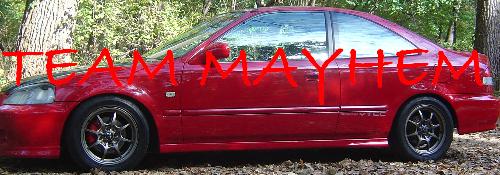BWM ///M3 GTR - the stuff wet dreams are made of.
An E46 GTR came to life on February 2001, powered by a 4000 cm³ V8 producing over 450 bhp also having the 4x4 steering. Unlike the straight-six powered M3 versions, which were outpaced by the Porsche 996 GT3, the racing version of the E46 M3 GTR V8 was very successful in the American Le Mans Series (ALMS), entered by Schnitzer Motorsport.
Rivals such as Porsche pointed out that this car was more of a prototype as no V8 engine was available in the road-going BMW E46, which is in violation of the spirit of Gran Turismo. In 2001, ALMS regulations stated that cars must be for sale on two continents within twelve months of the rules being issued. To fulfill this rule, BMW put 10 GTRs on sale after the 2001 season, for 250,000 euros (then $218,000) each, allegedly only available for select customers.
Due to this, the ALMS rules were altered for 2002 to state that 100 cars and 1000 engines must be built for the car to qualify without penalties. Although BMW could have raced the V8 with the new weight and power penalties under these new regulations, they chose to pull out of the ALMS, effectively ending the shortlived M3 GTR's career.
Two Schnitzer Motorsport GTR cars saw a comeback in 2003 at the 24 Hours Nürburgring, winning 1-2 in 2004 and 2005, as well as entries in the 24 Hours Spa. Onboard coverage recorded in 2004 Hans-Joachim Stuck, Pedro Lamy, Jörg Müller & Dirk Müller on the Nürburgring and Spa-Francorchamps.
A GTR was one of the theme cars in the 2005 video game Need For Speed: Most Wanted and returned on the new installment Need For Speed: Carbon. The racing version of the car (as seen at the 24 Hours Spa in 2004) features in the 2006 game GTR - FIA GT Racing Game 2.
Private teams (Scheid, Getrag, etc.) also have fit 4000cc BMW V8 engines into the E46 body to race on the Nürburgring, winning some VLN races in the last years.
Vids-
still photos, race clips, in car clips of a few race events, awsome vid
in car full Nurburgring, old vid but never gets old












Technology of the BMW M3 GTR
M3 extreme.
A muscular presence and a big heart: the BMW M3 GTR makes its mark
with a beefy body partly constructed of carbon-fibre, an output of more than 500 bhp from a V8 engine, and a thoroughbred racing chassis.
BMW Motorsport originally designed the GT Coupé to compete in the American Le Mans Series (ALMS). In the 2001 season, the BMW M3 GTR took the title in every class: BMW works driver Jörg Müller won the
Drivers’ Championship in the GT Class, BMW Motorsport took the Team title, and BMW came top of the Manufacturers’ standings in the company’s
most important export market. In seven out of eight races, the BMW M3 GTR was first to cross the finish line.
The fundamental difference to the production M3 lies in the driveline.
The GTR is driven by a 4.0-litre V8 rather than a 3.2-litre straight-six engine. For improved aerodynamics, the M3 GTR has a front air dam extended
forward by seven centimetres compared with the M3, a five-centimetre longer tail end, and a superstructure that is lower by around two centimetres.
To comply with the regulations of the Nürburgring 24 Hour Race,
in particular the stringent noise and emissions standards, comprehensive and in part performance-reducing modifications had to be carried out.
Both BMW M3 GTRs will be contesting Class E1 reserved for works teams.
The engine.
At the heart of the GTR is a V8 engine producing more than 500 bhp in race trim. A short-stroke, high-revving unit, it is fully in the tradition of M
engines and lent itself to the BMW M3 GTR not least by virtue of its compact dimensions. A bank angle of 90% and a flat oil pan with dry sump lubrication meant it could be mounted in the M3. Lengthwise, the four-litre V8 takes up a space two cylinders short of that of the M3’s straight-six, which allowed
for a new cooling concept. Immediately behind the front dam with its huge air intake, the water cooler (left) and oil cooler (right) are located next to each
other at an oblique angle. The outlets for the air collected from below can be seen on the bonnet.
This positioning is a very efficient solution both thermally and aerodynamically. It allows for greater downforce without significantly increasing drag.
The coolers for the gearbox and differential are located at the rear of the car.
When it came to the model P60 engine, the greatest challenge was to provide sufficiently large flow cross-sections for the intake and exhaust side.
The P60 is aspirated by two air restrictors, as per regulations, which limit the intake cross-section to a diameter of 32 mm per cylinder bank. (In the ALMS the diameter of the air restrictors last measured 30.4 mm.) The trumpet-shaped air restrictors necessary for optimal cylinder charging are visible above the coolers.
In addition to the successful design of the flow channels, the V8 also features an efficient combustion chamber design. The engine has a rotary valve
sleeve per cylinder and an engine control system specially developed by
BMW Motorsport. Says BMW Motorsport Director Mario Theissen:
“Like all M engines, this V8 offers remarkably good efficiency, which makes
it well suited to long-distance races.”
A traction control system, which was not permitted by the ALMS regulations, has been specially integrated into the engine control unit specially for 24-hour events.
The block and cylinder head of the V8 unit are made of aluminium and were produced at the BMW foundry in plant Landshut, where BMW casts its Formula One engines close to the long-established foundry for production engine blocks.
Aerodynamics.
The Nordschleife at the Nürburgring demands a different aerodynamic setting compromise compared to the requirements of the generally slower American race tracks for which the BMW M3 GTR was developed. These measures are also mirrored in the car’s appearance.
The aerodynamic concept of the M3 GTR was originally developed using a
40 per cent scale model in the wind tunnel and later optimized with 1:1 model and simulation programs. While the front end is also designed for downforce on the front axle and optimal cooling air supply, the extended rear end is used to enhance the aerodynamic efficiency of the rear wing. For greater high-speed stability, the underbody is largely even. Concessions had to be made here for 24-hour racing with regard to the silencer system and the catalytic converters.
Chassis.
The racing chassis of the BMW M3 GTR features stiff, welded steel hub carriers, a greater track width compared to the production model,
an extremely low-slung superstructure and axle kinematics in keeping with this. A forgiving suspension tuning which is also designed for high speeds
is particularly important on the Nordschleife. The balanced weight distribution of the BMW M3 GTR allows for an optimal set-up for this particular circuit.
The rack-and-pinion steering has electro-hydraulic power assistance to take the strain off drivers.
The 18-inch alloy racing wheels by BBS have been strengthened in comparison with the ALMS involvement. In the ALMS the minimum kerb weight was 1,100 kilograms, while the Nürburgring prescribes 1,250 kg.
While the standard unitary M3 steel body and welded safety cell of highly
rigid steel ensure structural stiffness, the M3 GTR, like the basic M3 version, features a thrust plate on the front axle for even greater driving accuracy.
For the new racing involvement, the rear axle has also been equipped with a stiffening thrust plate.
The brake system has been adapted to the extreme demands of the 24-hour races and, in collaboration with ContiTeves, has received a racing ABS system.
For improved driveline efficiency, the M3 GTR has a so-called step-up differential. Despite a low-positioned differential, it allows for minimal working angles of the transmission output shafts and features a combination of a viscous and multi-plate lock.
The safety tank system is located in a protective carbon-fibre sump below the boot and has been modified for fuelling with an injection nozzle. Tank capacity has been increased from 100 to 120 litres. Refuelling times during a pit stop on the Nürburgring are determined by the standard flow rate of the fuel pumps, which means a service stop will take about three times as long as in the 2001 ALMS.
Vehicle specifications BMW M3 GTR.
Length: 4,612 mm
Width: approx. 1,900 mm maximum as per regulations
Height: approx. 1,320 –1,330 mm
Wheelbase: 2,731 mm
Track: 1,609 mm front, 1,602 mm rear
Weight: 1,250 kg (minimum weight as per regulations)
Tank capacity: 120 litres (maximum capacity as per regulations)
Chassis/Body: unitary construction steel body with welded safety cell
of highly rigid precision steel tubing; front and rear aprons, bonnet, doors, front wings, rear wing extensions, rear wing, rear cover, roof outer layer and rear diffusor made of carbon-reinforced plastic;
partially smooth underbody made of sheet steel, safety fuel tank below the luggage compartment made
of carbon fibre-reinforced plastic sandwich, pneumatic four-stamp rapid jack system
Transmission: pulled triple-disc carbon-fibre clutch; straight-cogged six-speed manual gearbox with oil/air cooling at rear; step-up differential with viscous lock and mechanical spreader and multi-plate differential; steel drive shafts with tripod links
Front axle: single-pivot strut axle with friction-reduced strut bearings; four-position adjustable shock absorbers; welded hub carriers in steel design;
anti-roll bar with adjustment rods
Rear axle: central link-arm axle with welded longitudinal link in steel and double wishbone; four-position adjustable shock absorbers; anti-roll bar with adjustment rods
Brakes: racing ABS system, ContiTeves
Front: six-piston monoblock aluminium callipers; inner-vented
grey cast-iron brake discs of 380 mm diameter
Rear: four-piston monoblock aluminium callipers;
inner-vented grey cast-iron disc brakes
of 313 mm diameter;
Steering: rack-and-pinion steering with electro-hydraulic power assistance
Wheels: forged aluminium rims from BBS with integral drive pegs, diameter 18 inches, width 11 inches
Tyres: Michelin racing tyres sizes 27/65-18 (front)
and 27/68-18 (rear)
Engine specifications BMW V8.
Type: 8 cylinder naturally aspirated V engine
with 90-degree bank angle
Displacement: 3,997 cc
Bore x stroke: 94 x 72 mm
Compression ratio: 13:1
Max output: 500 bhp at approx. 8,000 rpm
Max torque: approx. 480 Nm at approx. 6,500 rpm
Max engine speed: approx. 8,500 rpm
Cylinder block: aluminium construction with nikasil-coated and exposure-honed liners
Pistons: forged box pistons
Connecting rods: highly rigid steel
Cylinder head: rigid aluminium construction with spherical valve arrangement, four valves per cylinder
Valve operation: four overhead camshafts, chain drive, mechanical bucket tappets
Intake system: rotary valve sleeves, air collector made of carbon fibre-reinforced plastic with load change-optimised swing tubes, two air restrictors with a diameter of 32 mm each
Exhaust system: high-performance header with additional silencer,
two catalysts and side outlet
Fuel system: single-cylinder injection with one injection valve per cylinder, injection pressure approx. 5 bar
Lubrication system: dry sump with oil tank in luggage compartment
Cooling: water/air and oil/air cooler
Flywheel: steel
Fuel: uniform fuel, premium unleaded
Electrical system/Electronics.
Engine: BMW ECU 12A-V8 with three high-performance microprocessors, external ignition drivers close to spark plugs, eight individual ignition coils, grid switchover function controllable by driver, individual cylinder injection and ignition, engine logbook, integral traction control
Vehicle: four xenon headlamps with special light module and two corner lights; multifunction steering wheel with six special functions; carbon fibre-reinforced racing display with programmable multifunctional LCD display and integral switch lamps; special racing safety wiring harness; 42-channel data recording system, telemetry system for car-to-pits data transmission






































